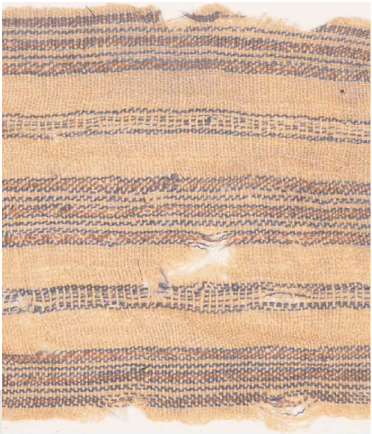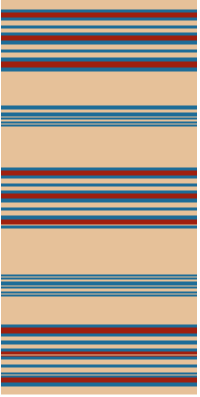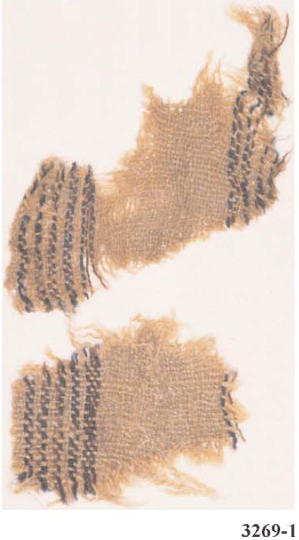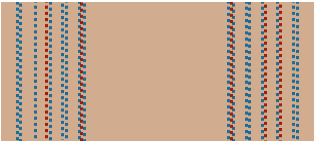As I am working making sharable info about these Durrnberg textiles, I am clearly seeing "types" of cloth. Most of the textiles are solid colored fabrics, but there are clusters of other types that show up. One of the most common ones are wool tabby textiles with a light colored base fabric and blue (or blue-green) and red (or red-brown) narrow stripes. There are at least 21 textiles from the site that are a light background with narrow stripes. At least five of those (potentially more) are bands.
Here are two examples, one was definitely a woven band in this type of cloth and the other might have been. Were these sashes worn at the waist or some other type of functional strap? We don't really know, but I would be comfortable wearing such a thing as a sash/belt. The narrower one (with less stripes) has only one selvedge intact, so we cannot be sure if it was a fragment of a larger cloth or if it was a narrow sash. My recreated image assumes mirroring of the pattern. It would be approximately 2.5 inches wide. The other was definitely a woven band and was about 4.6 inches wide. Both appear to be densely woven and at least somewhat sturdy.
These were probably woven on a warp-weighted loom, but modernly could be reproduced on a floor loom, or even a rigid heddle loom if you use two heddles for double the thread count.
We see a number of woven bands like this at both Dürrnberg and Hallstatt. If you are not a weaver you could hem a length of cloth to simulate the effect (and in fact, in the much, much later Martres de Veyre find there is a long sash that was sewn out of cloth, rather than being woven in the appropriate width from the outset). This might be a great way to use up excess cloth in your stash!
My eventual plan is to group the patterned textiles from both Hallstatt and Durrnberg and do diagrams with a scale for each and share that as a sort of "buying guide" that one can use to help shop for early, early period textiles.
Here are two examples, one was definitely a woven band in this type of cloth and the other might have been. Were these sashes worn at the waist or some other type of functional strap? We don't really know, but I would be comfortable wearing such a thing as a sash/belt. The narrower one (with less stripes) has only one selvedge intact, so we cannot be sure if it was a fragment of a larger cloth or if it was a narrow sash. My recreated image assumes mirroring of the pattern. It would be approximately 2.5 inches wide. The other was definitely a woven band and was about 4.6 inches wide. Both appear to be densely woven and at least somewhat sturdy.
These were probably woven on a warp-weighted loom, but modernly could be reproduced on a floor loom, or even a rigid heddle loom if you use two heddles for double the thread count.
We see a number of woven bands like this at both Dürrnberg and Hallstatt. If you are not a weaver you could hem a length of cloth to simulate the effect (and in fact, in the much, much later Martres de Veyre find there is a long sash that was sewn out of cloth, rather than being woven in the appropriate width from the outset). This might be a great way to use up excess cloth in your stash!
My eventual plan is to group the patterned textiles from both Hallstatt and Durrnberg and do diagrams with a scale for each and share that as a sort of "buying guide" that one can use to help shop for early, early period textiles.




 RSS Feed
RSS Feed